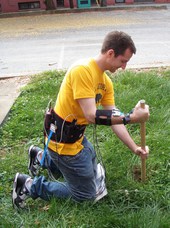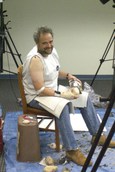IGERT Story
Biomechanical analysis of human tool use
Description
Students in GWU’s Brains, Bodies, & Ecology IGERT are utilizing a Pliance sensor system to collect pressure data acting on the human hand during various kinds of tool production and use. By understanding the selective forces acting on modern human anatomy, the students hope to elucidate whether early human fossils show evidence of tool use. Erin Marie Williams, whose research is also funded by an NSF-DDIG and Wenner-Gren Foundation Dissertation Fieldwork Grant, has been using the sensor system to study pressures produced during Oldowan stone tool production. Her work with experienced flint knappers has called into question previous hypotheses concerning the role of the thumb in stone tool production, and was presented at the 2010 meeting of the American Association of Physical Anthropologists in Albuquerque. Andrew Zipkin used the system to conduct a study of hand stabilization during archery. He also equipped fellow students with digging sticks in order to measure pressures on the thumb while foraging for underground storage organs, an important food source for early humans. The results of his study were presented at the 2010 meeting of Paleoanthropology Society in St. Louis. Students in the program’s Human Functional Anatomy course measured pressure on the hand during butchery activities practiced by extant human hunter-gatherer populations. Their work hints at anatomical adaptations in the hand reflecting behaviors for precision gripping of the small stone flakes typically used in butchery. Not wanting to be wasteful, the students held a BBQ in order to consume the goat used for the experimental trials.









